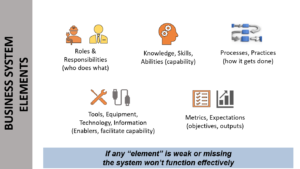Two Minutes on Manufacturing Excellence – The Power of Systems Thinking (Part II)
 In our previous article (read first), we talked about the value of thinking models and in particular “systems thinking”. To support systems thinking we identified the 5 Elements of a Business System. And we said that every business system is comprised of these same 5 elements. Now let’s dig into systems thinking a little further.
In our previous article (read first), we talked about the value of thinking models and in particular “systems thinking”. To support systems thinking we identified the 5 Elements of a Business System. And we said that every business system is comprised of these same 5 elements. Now let’s dig into systems thinking a little further.
I sometimes call systems thinking “instant business genius”. And here’s why.
Common Weak Thinking
By our nature, we tend to have two weaknesses in our thinking, especially when we view a problem.
One, we often think that what we know is what there is to know. We erroneously don’t respect the fact that any of us can only know a percentage, often a small percentage, of what there is to know and understand about a situation or a problem.
The other common thinking weakness is we see problems “in isolation” – we might say within a small “immediately viewable” circle of causes and effects.
Those two “thinking weaknesses” lead to reactivity as a way of operating. They cause us to draw conclusions and implement solutions that range from totally ineffective to limited or partial success. Surely we can do better.
“Seeing” the System
In the workplace there are “3 levels of activity” going on all the time:
- The specific tasks being done
- The larger business process that the task is a part of
- The overall output of the process (both expected and actual)
And along with that activity we have our “5 Elements of a Business System”:
- Roles and Responsibilities (R&Rs)
- Knowledge skills and abilities (KSAs)
- Work processes
- Enablers (tools, equipment technology, info)
- Expectations and metrics
Systems thinking has our mind’s eye “seeing” the workplace in terms of all 3 of those levels and all 5 of those elements all the time. We’re seeing the workplace as a system. It’s not hard to do if we make efforts to do it. And with that we carry an assumption. That is, that if any of those 5 elements is weak, let alone a combination of them, then the process and the outputs will almost certainly be sub-par.
Seeing Problems Systematically
So when a problem occurs, we immediately “see” the problem within the context of the system. It’s easy to see how that perspective immediately defeats those two weak thinking tendencies. And do you now get why Deming said that problems are 93% because of the system?
In our next article we’ll use an example to apply systems thinking and then begin to talk about another powerful thinking model.